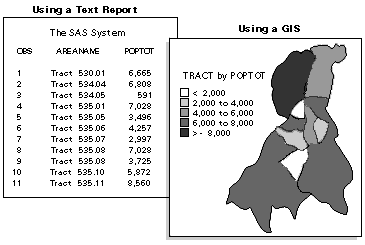SAS/GIS software provides
an interactive geographic information system within SAS. A geographic
information system (GIS) is a tool for organizing and analyzing data
that can be referenced spatially, that is, data that can be tied to
physical locations. Many types of data have a spatial aspect, including
demographics, marketing surveys, customer addresses, and epidemiological
studies. A GIS helps you analyze your data in the context of location.
For example, if you
need to evaluate population data for census tracts, you could view
the information in tabular format. However, consider how much easier
and more effective it is to view the demographic information in the
context of the geography of the tracts as shown in the following figure.
When viewing information that has a spatial component, you might find
it easier to recognize relationships and trends in your data if you
view the information in a spatial context.
SAS/GIS software enables
you to do more than simply view your data in its spatial context.
It also enables you to interact with the data by selecting features
and performing actions that are based on your selections.
SAS/GIS
software draws on the capabilities of SAS and enables you to access,
manage, analyze, and present your data easily.
